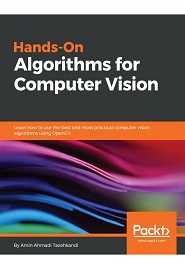
English | 2018 | ISBN: 978-1789130942 | 290 Pages | PDF, EPUB | 162 MB
Hands-On Algorithms for Computer Vision: Learn how to use the best and most practical Computer Vision algorithms using OpenCV
Create powerful, accurate, and real-time Computer Vision applications using a perfect blend of algorithms and filters. Also learn about object tracking and foreground extractions with a variety of new filters and algorithms.
An arena that has been positively impacted by the advancements in processing power and performance is the field of Computer Vision. It’s only natural that over time, more and more algorithms are introduced to perform Computer Vision tasks more efficiently. Hands-On Algorithms for Computer Vision is a starting point for anyone who is interested in the field of Computer Vision and wants to explore the most practical algorithms used by professional Computer Vision developers. The book starts with the basics and builds up over the course of the chapters with hands-on examples for each algorithm.
Right from the start, you will learn about the required tools for computer vision development, and how to install and configure them. You’ll explore the OpenCV framework and its powerful collection of libraries and functions. Starting from the most simple image modifications, filtering, and transformations, you will gradually build up your knowledge of various algorithms until you are able to perform much more sophisticated tasks, such as real-time object detection using deep learning algorithms.
What You Will Learn
- Get to grips with machine learning and artificial intelligence algorithms
- Read, write, and process images and videos
- Perform mathematical, matrix, and other types of image data operations
- Create and use histograms from back-projection images
- Detect motion, extract foregrounds, and track objects
- Extract key points with a collection of feature detector algorithms
- Develop cascade classifiers and use them, and train and test classifiers
- Employ TensorFlow Object Detection to detect multiple objects
Resolve the captcha to access the links!